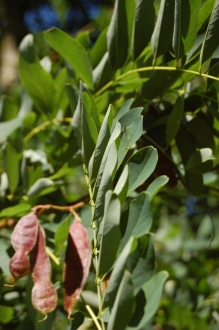Position: Full sun to light shade
Flowering period: Early summer
Soil: Moist, well drained
Eventual Height: 10m
Eventual Spread: 8m
Hardiness: 3b, 4a, 4b, 5a, 5b, 6a, 6b, 7a, 7b, 8a, 8, 9a
Family: Fabaceae
Robinia viscosa is a small/ medium sized deciduous tree with an open habit and a broadly ovoid crown. Its mid green leaves are pinnate and are made up of up to 21 leaflets. Its leaflets are oval with entire margins and up to 5cm long. Its young branches are usually thorny and covered with short glandular hair which exude a sticky substance. Its bark is grey with rough groves. Its dark pink hermaphrodite flowers are similar to those of the pea, typical of this genus. Its dark brown fruit is a flat pod and is up to 8cm long. Its roots fix nitrogen in the soil.
Robinia viscosa, commonly known as the Clammy Locust or Viscous Robinia, is native to east North America.
The etymological root of the binomial name Robinia is named after Jean Robin, a 17th century French botanist and herbalist to Henry IV and Louis XIII of France, and Vespasian Robin his son. Viscosa is derived from the Latin meaning ‘sticky’.
The landscape architect may find Robinia viscosa useful as a tree to stabilise banks, particularly on poor soils. It also makes an attractive parkland tree. It is tolerant of atmospheric pollution. Once established this tree is drought tolerant.
Ecologically, Robinia viscosa is attractive to pollinating insects.
Robinia viscosa prefers moist, well-drained soils. It tolerates most pH of soil. It will tolerate nutrient poor soils.
Robinia viscosa requires little maintenance. Pruning should be carried out in late summer.








Leave a comment